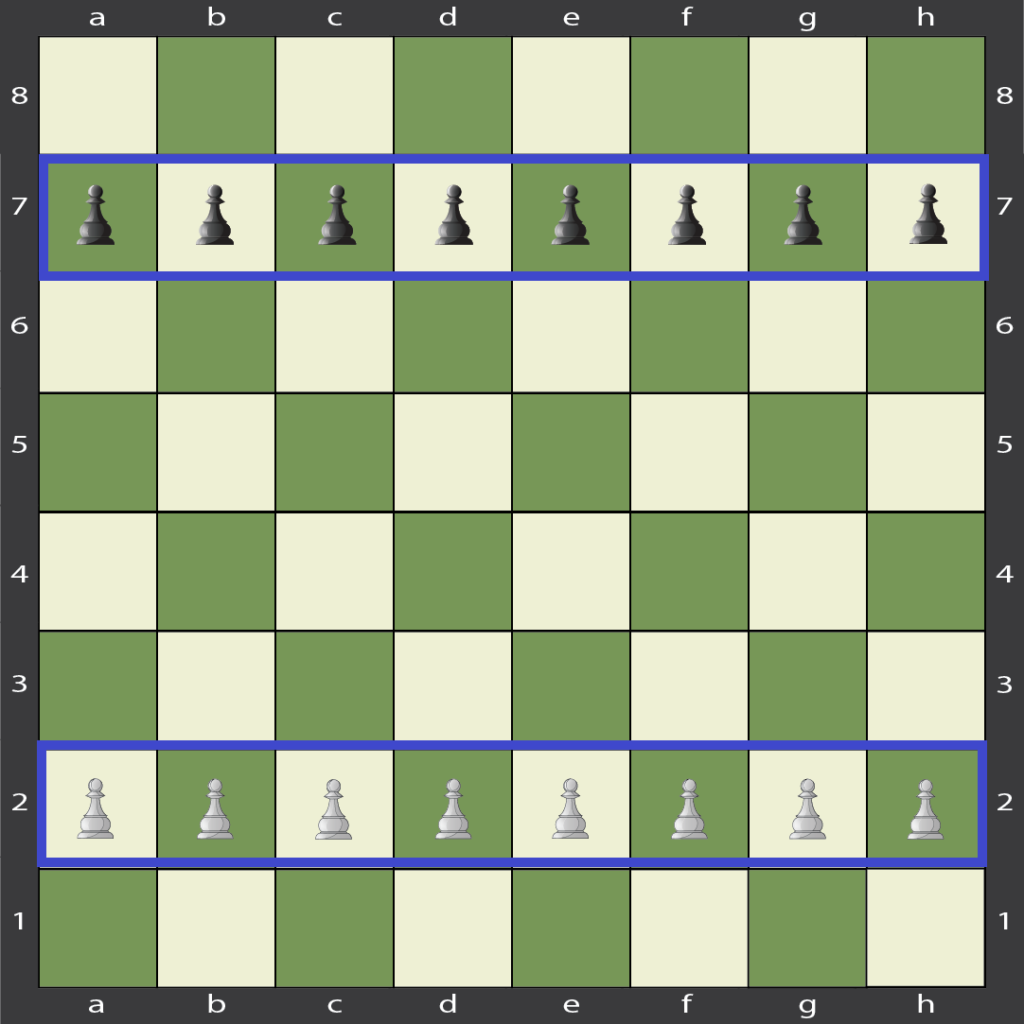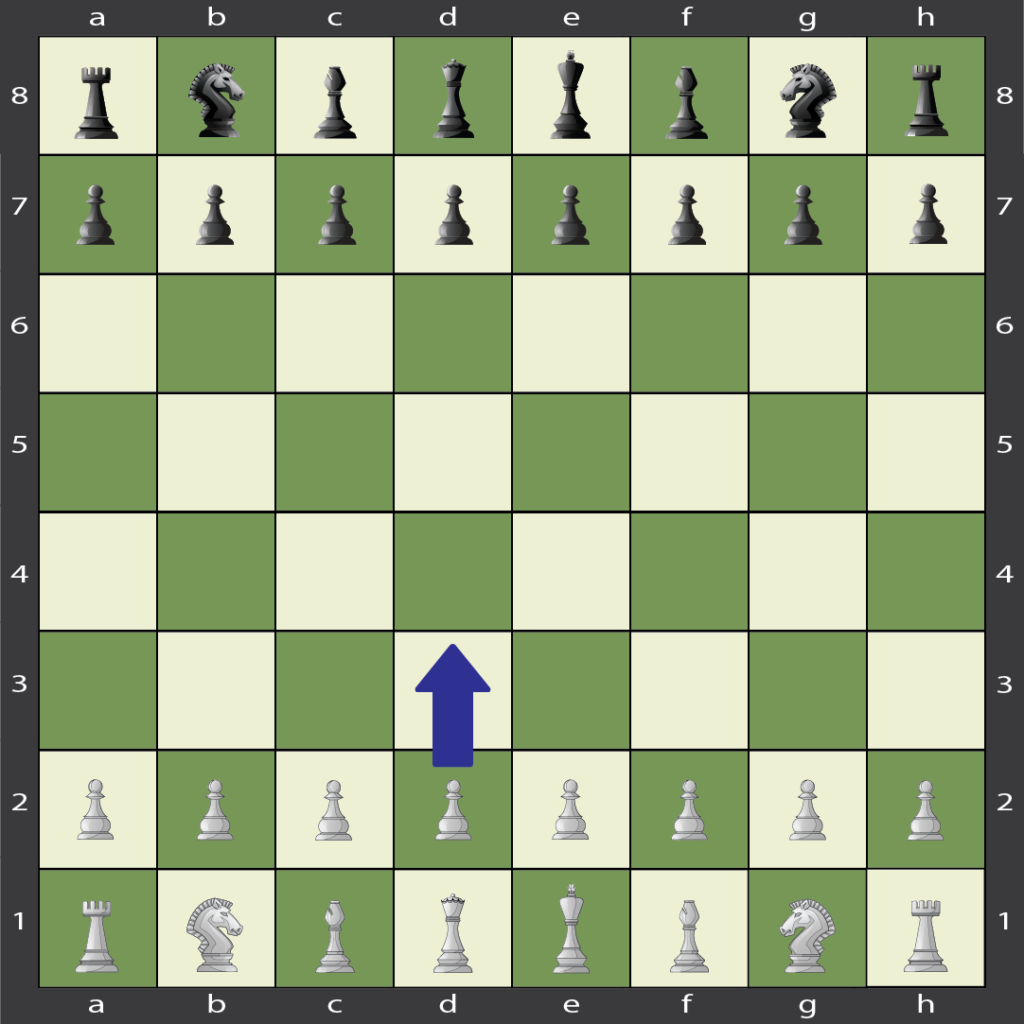
The pawn in chess may be the humblest piece on the chessboard and seem unremarkable at first glance, but it possesses a subtle power that can shape the entire game. Lining the front ranks of the player’s army, the pawn in chess serves as the game’s first line of defense and offense.
Table of Contents
The Pawn in Chess on the Board
At the start of any chess game, Pawns line the front ranks of the player’s army, serving as the game’s first line of defense as well as offense.

How the Pawns in Chess Move
They move forward one square at a time, but on their initial move, they can advance two squares, adding a layer of strategic flexibility:


The pawn in chess capture diagonally, removing enemy pieces in their path (see image below).

In the intricate dance of the chessboard, the pawn may appear insignificant, but its impact can be profound, and it often plays a crucial role in determining the outcome of the battle.
Pawn Promotion
The true strength for a pawn in chess lies in their promotion—their unwavering determination to reach the opposite end of the board, transforming into any other piece upon reaching the eighth rank. This transformation symbolizes the pawn’s journey from a humble soldier to a powerful officer.
In rare cases, a player may promote multiple pawns to the same piece during a game. This occurrence can lead to multiple queens, rooks, knights, or bishops on the board, significantly altering the dynamics of the game.
Whenever a pawn reaches the other side of the board, it is immediately turned into either a new queen, rook, bishop, or knight. It is not possible to promote a pawn into another king.
Pawn Chess Piece: Further Reading
Historical Origins
The pawn’s movement and role in chess can be traced back to its origins in ancient India. In the early Indian version of the game, known as Chaturanga, pawns represented infantry soldiers or foot soldiers in the kingdom.
The pawn’s initial two-square movement was introduced in Europe during the Middle Ages. Originally, pawns could only move one square forward, but this rule was changed to allow the double-step move to speed up the game’s opening phase.
The “en passant” rule, which allows a pawn to capture an opponent’s pawn that moves two squares forward from its starting position, was introduced in the 15th century. This rule was designed to prevent players from avoiding pawn captures and adds a tactical nuance to the game.
Pawn Islands
In chess strategy, groups of isolated pawns on the board are referred to as “pawn islands.” These pawn structures can have significant implications for the position, as they may be vulnerable to attack or difficult to defend.
Pawn Majorities
A “pawn majority” occurs when a player has more pawns on one side of the board compared to the opponent. Utilizing pawn majorities is a critical element of endgame strategy, as they can be used to create passed pawns and secure a positional advantage.
The Pawn Chain
A “pawn chain” refers to a series of connected pawns on adjacent files. A well-structured pawn chain can be a powerful defensive barrier, blocking the opponent’s advancement and controlling key squares.
Despite its initial unassuming appearance, the pawn’s historical evolution and unique rules have made it a vital and intriguing piece in the game of chess. From its origins as a lowly foot soldier to its potential to transform into a powerful officer, the pawn embodies the essence of growth, strategy, and subtle power on the chessboard.
Tips for Using Your Pawns in Chess
- Remember they cannot move backwards, so move wisely!
- Pawn Chains are Strong, Isolated Pawns are Usually Weak
- Use Pawn Promotion as a Tool to Pressure Your Opponent in the Endgame
Pawn in Chess – Frequently Asked Questions
How Does the Pawn Move in Chess?
The pawn can move one square forward, two squares forward on its first move, and attack one square diagonally forward. Additionally, the pawn can capture en passant.
Can the Pawn Move Backwards?
No, the pawn can’t move backwards. It is the only piece that can only advance forwards.
Can the Pawn Jump Over Other Pieces?
No, the pawn cannot jump over other pieces under any curcumstances.
How Much is a Pawn Worth?
Usually, the pawn itself is the measurement for the relative value of other chess pieces. But speaking from a strictly mathematical standpoint, the pawn is worth ⅓ of a bishop (or knight), ⅕ of a rook and ⅑ of a queen.
What Happens When a Pawn Reaches the Other Side of the Board?
Whenever a pawn reaches the enemy’s back rank, the pawn is immediately upgraded to a queen, rook, bishop, or knight of the same color. This concept is called pawn promotion.
Can a Pawn Take a King?
Theoretically, the king can never be captured. It can only be checkmated. In that sense, the pawn can checkmate a king.
Affiliate Disclosure
Some of the links on Chesspert.com are affiliate links. This means that we may earn a small commission if you click through and make a purchase, at no additional cost to you. Please note that our product reviews and roundups are independent, and the affiliate relationships do not influence our content in any way.
Chesspert.com is a participant in the Amazon Services LLC Associates Program, an affiliate advertising program designed to provide a means for sites to earn advertising fees by advertising and linking to Amazon.com.
Chesspert.com is also a participant in the GammonVillage Inc. Affiliate Program, an affiliate advertising program designed to provide a means for sites to earn advertising fees by advertising and linking to GammonVillage.com.
Amazon and the Amazon logo are trademarks of Amazon.com, Inc. or its affiliates. GammonVillage is a trademark of GammonVillage Inc. or its affiliates.
Our passion for board games extends far beyond the chess table. We’ll be your trusted companion, on a journey through the enchanting realms of not only chess but also backgammon, dominoes, mahjong, checkers, and a diverse array of other captivating board games.
Whether you’re in search of the ideal chess set, luxury backgammon sets, a chinese checkers set, a checkers set, or if you’re seeking the excitement of a thrilling game of mahjong solitaire, we’ll guide you along the way.
In partnership with our affiliates, we bring you an extensive selection of board games and past times to explore and enjoy.
Still not enough? Then unwind and relax with a unique jigsaw puzzle on a cleared flat surface, or jigsaw table top. Our platform serves as a dynamic hub where curiosity converges with expertise, and entertainment merges with strategy.
Dive into our extensive collection of guides and reviews, and unlock the joy and exhilaration that board games offer. From exquisitely crafted game pieces to the essential accessories that elevate your gaming experience, we’re here to guide you through it all with ease and delight.
Join us in celebrating the timeless allure and camaraderie that these games nurture, one post at a time!






